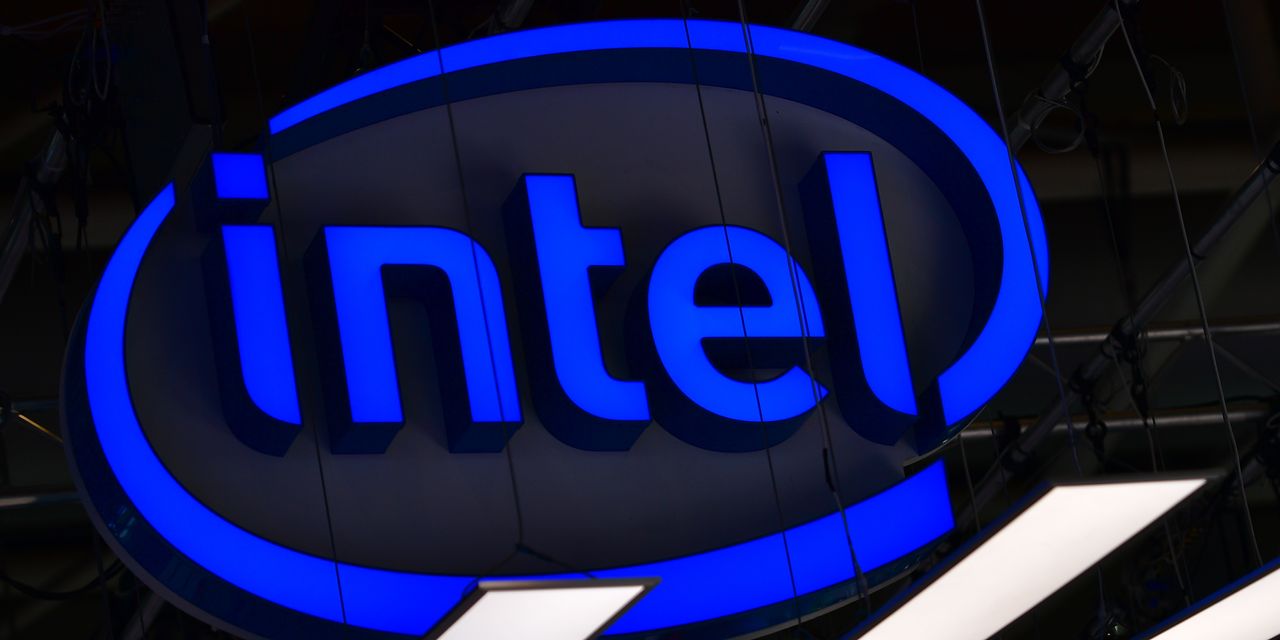
Intel Corp. shares weakened in the extended session Thursday after the chip maker’s outlook barely surpassed the Wall Street consensus while forecasting the global chip shortage could last well into 2023.
Intel INTC, -0.48% shares fell more than 3% in the extended session, following an initial 3% uptick in after-hours trading. By the end of the conference call with analysts, shares were down about 2%. The stock closed down 0.5% in the regular session at $55.96.
For the third quarter, Intel forecast revenue of about $19.1 billion, or $18.2 billion when removing the memory business, and GAAP earnings of $1.08 a share and non-GAAP earnings of $1.10 a share. Analysts on average expected adjusted third-quarter earnings of $1.09 a share on revenue of $18.11 billion.
On the conference call, Intel Chief Executive Pat Gelsinger told analysts he expects chip shortages to bottom out in the second half of the year, but that it will take “another one to two years before the industry is able to completely catch up with demand.”
“The world needs more semiconductors,” Gelsinger said. “The world needs a more balanced geographic supply chain for those semiconductors, and we’re finding enormous momentum and enthusiasm for that strong support from the customers, the ecosystem, as well as governments around the world.”
On Wednesday, Texas Instruments Inc. TXN, -5.32% kicked off earnings season for U.S. chip makers, topping Wall Street estimates but confusing some analysts with a conservative guidance amid a global semiconductor shortage. As chip makers, like Texas Instruments and Intel, invest more in foundry capacity and ramp up production, investors don’t want to see a repeat of 2018, when high chip demand quickly turned into a supply glut after customers double- or triple-bought chips as prices rose and chip makers kept on producing product.
Intel reported second-quarter net income of $5.06 billion, or $1.24 a share, compared with $5.11 billion, or $1.19 a share, in the year-ago period. After adjusting for acquisition-related expenses and other items, Intel reported earnings of $1.28 a share, compared with $1.23 a share from a year ago.
Revenue declined to $19.63 billion from $19.73 billion in the year-ago quarter, for a fourth straight quarter of year-over-year revenue declines, but topped its own and analysts’ estimates. Excluding the company’s memory business, revenue was $18.5 billion. Analysts had estimated adjusted earnings of $1.07 a share on revenue of $17.81 billion, while Intel had forecast adjusted earnings of $1.05 a share on revenue of $18.9 billion, or $17.8 billion when removing the memory business it was divesting.
Read: The chip crunch marches on, but one sector could be in store for relief
Intel’s data-center group revenue declined 9% to $6.5 billion, while analysts surveyed by FactSet expected $5.84 billion, while Intel’s largest segment — client-computing, the traditional PC group — rose 6% to $10.1 billion, with analysts expecting $10.03 billion.
Intel reported that nonvolatile memory-solutions revenue fell 34% to $1.1 billion, while Wall Street expected $690.8 million, and “Internet of Things,” or IoT, revenue rose 47% to $984 million, compared with an expected $901.5 million. Mobileye revenue soared 124% to $327 million, but the Street had expected $361.4 million.
Read: Why chip stocks are falling despite semiconductor shortage, strong early earnings
Regarding rumors that Intel was looking to acquire GlobalFoundries, Gelsinger said he could not comment on rumors and said he “very happy with the build-out” of Intel’s foundry services business, or IFS, but wouldn’t rule out acquisitions.
On its expansion for foundry services, Gelsinger said it has already talked to “about 100 customers that are talking to us about foundry opportunities.”
“Our view is that industry consolidation is very likely,” Gelsinger said. “The intense R&D, the need to move to modern and leading-edge nodes, the massive capital investments required, we just simply view that smaller players simply won’t be able to keep up and foundries without leading-edge capabilities will be left behind and we’re continually seeking ways to accelerate our plans with IFS.”
Regarding Intel’s delay on its Sapphire Rapids chip, Gelsinger said the company “did ad a bit more time for the validation cycle,” and that it was “in the hands of customers and that volume sampling [is] under way.”
Over the past 12 months, Intel stock has fallen 8%. Over the same period, the Dow Jones Industrial Average DJIA, +0.07% — which counts Intel as a component — has gained 29%, the S&P 500 index SPX, +0.20% has climbed 33%, the tech-heavy Nasdaq Composite Index COMP, +0.36% has advanced 40%, and the PHLX Semiconductor Index SOX, -0.89% has surged 55%.





